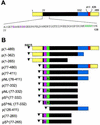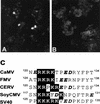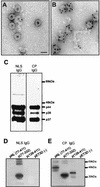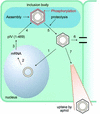Nuclear targeting of the cauliflower mosaic virus coat protein
- PMID: 9847360
- PMCID: PMC103861
- DOI: 10.1128/JVI.73.1.553-560.1999
Nuclear targeting of the cauliflower mosaic virus coat protein
Abstract
The entry of the viral genomic DNA of cauliflower mosaic virus into the nucleus is a critical step of viral infection. We have shown by transient expression in plant protoplasts that the viral coat protein (CP), which is processed from the product of open reading frame IV, contains an N-terminal nuclear localization signal (NLS). The NLS is exposed on the surface of the virion and is thus available for interaction with a putative NLS receptor. Phosphorylation of the matured CP did not influence the nuclear localization of the protein but improved protein stability. Mutation of the NLS completely abolished viral infectivity, thus indicating its importance in the virus life cycle. The NLS seems to be regulated by the N terminus of the precapsid, which inhibits its nuclear targeting. This regulation could be important in allowing virus assembly in the cytoplasm.
Figures






Similar articles
-
Mutation of capsid protein phosphorylation sites abolishes cauliflower mosaic virus infectivity.J Virol. 2002 Nov;76(22):11748-52. doi: 10.1128/jvi.76.22.11748-11752.2002. J Virol. 2002. PMID: 12388736 Free PMC article.
-
The product of ORF III in cauliflower mosaic virus interacts with the viral coat protein through its C-terminal proline rich domain.Virus Genes. 2001 Mar;22(2):159-65. doi: 10.1023/a:1008121228637. Virus Genes. 2001. PMID: 11324752
-
Regulated nuclear targeting of cauliflower mosaic virus.J Gen Virol. 2002 Jul;83(Pt 7):1783-1790. doi: 10.1099/0022-1317-83-7-1783. J Gen Virol. 2002. PMID: 12075100
-
Shunting and controlled reinitiation: the encounter of cauliflower mosaic virus with the translational machinery.Cold Spring Harb Symp Quant Biol. 2001;66:269-76. doi: 10.1101/sqb.2001.66.269. Cold Spring Harb Symp Quant Biol. 2001. PMID: 12762028 Review. No abstract available.
-
[Comparison between hepatitis B virus and cauliflower mosaic virus, which have gap structure in the genomic DNA].Uirusu. 1994 Jun;44(1):35-41. doi: 10.2222/jsv.44.35. Uirusu. 1994. PMID: 7856118 Review. Japanese. No abstract available.
Cited by
-
Analyses of phosphorylation events in the rubella virus capsid protein: role in early replication events.J Virol. 2006 Jul;80(14):6917-25. doi: 10.1128/JVI.01152-05. J Virol. 2006. PMID: 16809297 Free PMC article.
-
Mutation of capsid protein phosphorylation sites abolishes cauliflower mosaic virus infectivity.J Virol. 2002 Nov;76(22):11748-52. doi: 10.1128/jvi.76.22.11748-11752.2002. J Virol. 2002. PMID: 12388736 Free PMC article.
-
Interaction of the cauliflower mosaic virus coat protein with the pregenomic RNA leader.J Virol. 2000 Mar;74(5):2067-72. doi: 10.1128/jvi.74.5.2067-2072.2000. J Virol. 2000. PMID: 10666236 Free PMC article.
-
Top 10 plant viruses in molecular plant pathology.Mol Plant Pathol. 2011 Dec;12(9):938-54. doi: 10.1111/j.1364-3703.2011.00752.x. Epub 2011 Oct 21. Mol Plant Pathol. 2011. PMID: 22017770 Free PMC article. Review.
-
Setting Up Shop: The Formation and Function of the Viral Factories of Cauliflower mosaic virus.Front Plant Sci. 2017 Oct 30;8:1832. doi: 10.3389/fpls.2017.01832. eCollection 2017. Front Plant Sci. 2017. PMID: 29163571 Free PMC article. Review.
References
-
- Blanc S, Cerutti M, Usmany M, Vlak J M, Hull R. Biological activity of cauliflower mosaic virus aphid transmission factor expressed in a heterologous system. Virology. 1993;192:643–650. - PubMed
-
- Bock C T, Schwinn S, Schroder C H, Velhagen I, Zentgraf H. Localization of hepatitis B virus core protein and viral DNA at the nuclear membrane. Virus Genes. 1996;12:53–63. - PubMed
Publication types
MeSH terms
LinkOut - more resources
Full Text Sources
Other Literature Sources
Molecular Biology Databases
Miscellaneous

